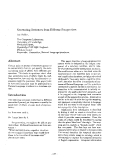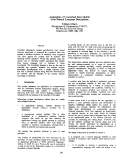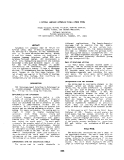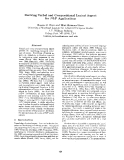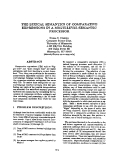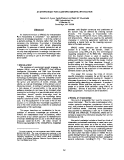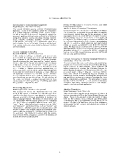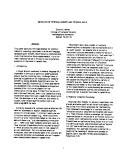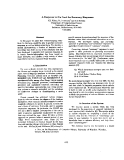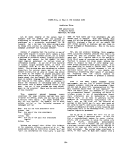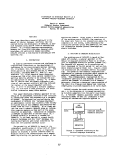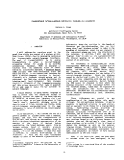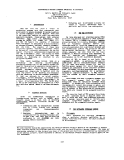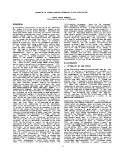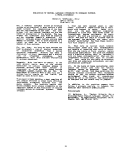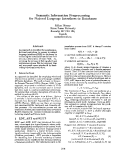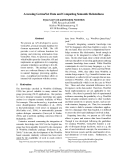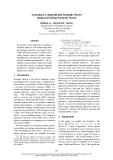
Natural language interfaces to database
-
Cohort definition is a bottleneck for conducting clinical research and depends on subjective decisions by domain experts. Data-driven cohort definition is appealing but requires substantial knowledge of terminologies and clinical data models. Criteria2Query is a natural language interface that facilitates human-computer collaboration for cohort definition and execution using clinical databases.
 12p
12p  visteverogers
visteverogers
 24-06-2023
24-06-2023
 7
7
 2
2
 Download
Download
-
Certain pairs or groups of sentences appear to be semantically distinct, yet specify the same underlying state of affairs, from different perspectives. This leads to questions about what that underlying state of affairs might be, and, for generation, how and why the alternative expressions might be produced. This paper looks at how such sentences may be generated in a Natural Language interface to a database system.
 6p
6p  buncha_1
buncha_1
 08-05-2013
08-05-2013
 43
43
 1
1
 Download
Download
-
Acquiring information systems specifications from natural language description is presented as a problem class that requires a different treatment of semantics when compared with other applied NL systems such as database and operating system interfaces. Within this problem class, the specific task of obtaining explicit conceptual data models from natural language text or dialogue is being investigated. The knowledge brought to bear on this task is classified into syntactic, semantic and systems analysis knowledge.
 8p
8p  buncha_1
buncha_1
 08-05-2013
08-05-2013
 65
65
 2
2
 Download
Download
-
Databases are nowadays used by varied and diverse users, many of whom are unfamiliar with the workings of a computer, but who, nevertheless, want to use those databases more easily. Rising to meet this demand, authors are developing a Japanese language interface, called KID, as a database front-end system. KID incorporates a world model representing application and database knowledge to help make databases easier to use.
 8p
8p  buncha_1
buncha_1
 08-05-2013
08-05-2013
 56
56
 2
2
 Download
Download
-
Verbal and compositional lexical aspect provide the underlying temporal structure of events. Knowledge of lexical aspect, e.g., (a)telicity, is therefore required for interpreting event sequences in discourse (Dowty, 1986; Moens and Steedman, 1988; Passoneau, 1988), interfacing to temporal databases (Androutsopoulos, 1996), processing temporal modifiers (Antonisse, 1994), describing allowable alternations and their semantic effects (Resnik, 1996; Tenny, 1994), and selecting tense and lexical items for natural language generation ((Dorr and Olsen, 1996; Klavans and Chodorow, 1992), cf.
 8p
8p  bunthai_1
bunthai_1
 06-05-2013
06-05-2013
 57
57
 3
3
 Download
Download
-
Comparative expressions (CEs) such as "bigger than" and "more oranges than" are highly ambiguous, and their meaning is context dependent. Thus, they pose problems for the semantic interpretation algorithms typically used in natural language database interfaces. We focus on the comparison attribute ambiguities that occur with CEs. To resolve these ambiguities our natural language interface interacts with the user, finding out which of the possible interpretations was intended.
 8p
8p  bungio_1
bungio_1
 03-05-2013
03-05-2013
 45
45
 1
1
 Download
Download
-
In this paper we present a formalization of the centering approach to modeling attentional structure in discourse and use it as the basis for an algorithm to track discourse context and bind pronouns. As described in [GJW86], the process of centering attention on entities in the discourse gives rise to the intersentential transitional states of continuing, re~aining and shifting. We propose an extension to these states which handles some additional cases of multiple ambiguous pronouns.
 8p
8p  bungio_1
bungio_1
 03-05-2013
03-05-2013
 30
30
 1
1
 Download
Download
-
An improved version of IRACQ (for Interpretation Rule ACQuisition) is presented. I Our approach to semantic knowledge acquisition: 1 ) is in the context of a general purpose NL interface rather than one that accesses only databases, 2) employs a knowledge representation formalism with limited inferencing capabilities, 3) assumes a trained person but not an AI expert, and 4) provides a complete environment for not only acquiring semantic knowledge, but also maintaining and editing it in a consistent knowledge base. IRACQ is currently in use at the Naval Ocean Systems Center. ...
 9p
9p  bungio_1
bungio_1
 03-05-2013
03-05-2013
 41
41
 2
2
 Download
Download
-
Topics to be considered include the components of a natural language processing system; syntax analysis (including context-free grammars, augmented context-free grammars, grammatical constraints, and sources of syntactic ambiguity); semantic analysis (including meaning representation, semantic constraints, quantifier analysis); and discourse analysis (identifying implicit information, establishing text coherence, frames, and scripts). Examples will be drawn from various application areas, including database interface and text analysis.
 1p
1p  bungio_1
bungio_1
 03-05-2013
03-05-2013
 55
55
 2
2
 Download
Download
-
This paper analyzes the requirements for adding a temporal reasoning component to a natural language database query system, and proposes a computational model that satisfies those requirements. A prelimInary implementation in Prolog is used to generate examples of the model's capabi Iltles. I. Introduction A major area of weakness in natural language (NL) interfaces is the lack of ability to understar~ and answer queries involving time.
 8p
8p  bungio_1
bungio_1
 03-05-2013
03-05-2013
 33
33
 1
1
 Download
Download
-
In this paper we argue that natural language interfaces to databases should be able to produce summary responses as well as listing actual data. We describe a system (incorporating a number of heuristics and a knowledge base built on top of the database) that has been developed to generate such summary responses. It is largely domain-independent, has been tested on many examples, and handles a wide variety of situations where summary responses would be useful.
 5p
5p  bungio_1
bungio_1
 03-05-2013
03-05-2013
 33
33
 1
1
 Download
Download
-
But I can take this stand strongly only by being very liberal in defining both "natural language interface" and "database systems". Instead of assuming that the problem is one of using typed English to access and/or update a file or files in a single database system, let us define a spectrum of potential natural language interfaces (limiting that phrase, for the moment, to mean typed English sentences) to various kinds of information systems. At one end of this spectrum is simple, single database query, in which the translation from NL to the db system is quite direct. ...
 2p
2p  bungio_1
bungio_1
 03-05-2013
03-05-2013
 48
48
 1
1
 Download
Download
-
This paper describes a general approach to the design of natural language interfaces that has evolved during the development of DATALOG, an English database query system based on Cascaded ATN grammar. By providing separate representation schemes for linguistic knowledge, general world knowledge, and application domain knowledge, DATALOG achieves a high degree of portability and extendability.
 4p
4p  bungio_1
bungio_1
 03-05-2013
03-05-2013
 48
48
 1
1
 Download
Download
-
I will address the questions posed to the panel from wlthln the context of a project at SRI, TEAM [Grosz, 1982b], that is developing techniques for transportable natural-language interfaces. The goal of transportability is to enable nonspeciallsts to adapt a natural-language processing system for access to an existing conventional database. TEAM is designed to interact with two different kinds of users.
 5p
5p  bungio_1
bungio_1
 03-05-2013
03-05-2013
 53
53
 2
2
 Download
Download
-
Over the last few years a number of application systems have been constructed that who has had special training in computational l i n g u i s t i c s and the use of databases. Thus, the utility of these systems is severely limited by the high cost involved in developing an interface to any particular database.
 8p
8p  bungio_1
bungio_1
 03-05-2013
03-05-2013
 43
43
 1
1
 Download
Download
-
IV Familiar with the database and the interaction language Ill Familiar with the contents of database II Familiar with the domain of application I Passing knowledge of the domain of application Of course, as users gain experience with a system, they will continually attempt to adapt to its quirks. If the purpose of the evaluation is to demonstrate that the natural language understanding system is merely useable.
 4p
4p  bungio_1
bungio_1
 03-05-2013
03-05-2013
 32
32
 2
2
 Download
Download
-
For a natural language access to database system to be practical it must achieve a good match between the capabilities of the user and the requirements of the task. The user brings his own natural language and his own style of interaction to the system. The task brings the questions that must be answered and the database domaln+s semantics. All natural language access systems achieve some degree of success. But to make progress as a field, we need to be able to evaluate the degree of this success. For too long, the best we have menaged has been to...
 2p
2p  bungio_1
bungio_1
 03-05-2013
03-05-2013
 47
47
 3
3
 Download
Download
-
An approach is described for supplying selectional restrictions to parsers in natural language interfaces (NLIs) to databases by extracting the selectional restrictions from semantic descriptions of those NLIs. Automating the process of finding selectional restrictions reduces NLI development time and may avoid errors introduced by handcoding selectional restrictions.
 3p
3p  bunmoc_1
bunmoc_1
 20-04-2013
20-04-2013
 32
32
 2
2
 Download
Download
-
We present an API developed to access GermaNet, a lexical semantic database for German represented in XML. The API provides a set of software functions for parsing and retrieving information from GermaNet. Then, we present a case study which builds upon the GermaNet API and implements an application for computing semantic relatedness according to five different metrics. The package can, again, serve as a software library to be deployed in natural language processing applications. A graphical user interface allows to interactively experiment with the system. ...
 4p
4p  bunbo_1
bunbo_1
 17-04-2013
17-04-2013
 57
57
 2
2
 Download
Download
-
We present a new approach to learning a semantic parser (a system that maps natural language sentences into logical form). Unlike previous methods, it exploits an existing syntactic parser to produce disambiguated parse trees that drive the compositional semantic interpretation. The resulting system produces improved results on standard corpora on natural language interfaces for database querying and simulated robot control.
 9p
9p  hongphan_1
hongphan_1
 14-04-2013
14-04-2013
 41
41
 1
1
 Download
Download
CHỦ ĐỀ BẠN MUỐN TÌM









